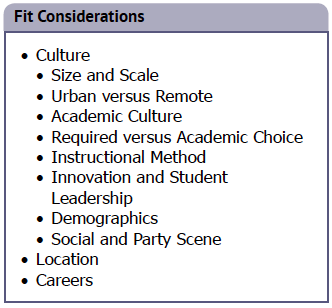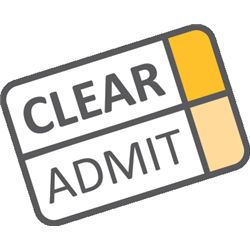Welcome back to our new 10-part series, in which we’ll run an excerpt from the recently published book, Becoming a Clear Admit: The Definitive Guide to MBA Admissions, with added commentary from its author, Alex Brown.
In this second part of the series, we look at determining school fit as it relates to helping candidates choose the appropriate schools to target.
Book Excerpt:
FIT
Culture
You want to attend an MBA program in which you will engage and thrive, and that also has the resources that are appropriate to your goals. You are more likely to do this when you consider your fit for individualprograms. So while you want to attend the highest-tier school you can, you also want to identify the program that will best serve you as an individual, one where you will thrive and that aligns with your goals.
Part of finding your best fit is considering how the school culture lines up with your personality, preferences, and values. There are many elements that help determine cultural fit, including size and scale, geography and type of location (urban versus non-urban), a collaborative versus a competitive student body, the academic environment and instructional methods, the demographics of the student body, and the social nature of the environment. Each of these variables contributes to the overall culture of the school and influences the student experience.
Size and Scale
Large programs comprise 1,500+ students across the two years. With that many MBA students, there is a strong likelihood that there will be other students in the program whose interests, goals, and background are similar to yours, no matter how niche they may be. This is especially important for students with non-traditional backgrounds and aspirations. This plays out particularly in the extra-curricular and career management aspects of the program, as well as the breadth of electives courses. The latter can be addressed if the school allows students to pursue electives within the wider university, as most do.
For smaller programs like Tuck and Haas, there may be less opportunity to pursue more narrowly focused interests, but there will typically be more engagement within the student body. It is harder to be anonymous in a smaller program, and you are likely to graduate knowing everyone who entered the program with you. Thus, smaller programs are able to offer a more intimate environment, which can translate to stronger bonds both during the program and as alumni of the program. Tuck’s alumni are notable for their support of their school; more than 70% of Tuck alumni contribute to the Tuck Annual Giving campaign, a figure that dwarfs all other top MBA programs.
In larger schools like Wharton and Harvard, you can make more connections, but on average those connections will be weaker and more superficial than those made in a smaller program. That being said, having access to a large network, and a wider variety of clubs and activities, is useful when seeking out individuals from a wide range of locations or industries during the program and in the future.
Author’s Commentary:
Last week we highlighted an excerpt from the book that focuses on a new, tiered ranking system designed to benefit candidates investigating which schools to target. Of course, once candidates have determined which tier of schools to target, they then need to examine the schools within that tier to better understand which schools offer the best fit for them as individuals. For example, though Chicago Booth, Columbia, Kellogg and MIT Sloan come out as essentially equivalent in terms of rankings—falling, as they do, within the same tier—this is not to suggest that a candidate can choose interchangeably between any of the four and have the MBA experience best suited to their needs and goals.
In the above excerpt, I explore the notion of cultural fit, i.e. how a candidate will be able to make the most of the two-year experience of the MBA program. Each of the elements of cultural fit are highlighted in the figure above. “Size and scale,” one aspect of cultural fit, is detailed in the excerpt.
There are basically three dimensions to fit: cultural fit, geographic fit and career goal fit.
Geography is important for two reasons. First, a school’s location impacts the direct MBA experience. Some students, for example, will want to study in a location where it is generally always sunny, whereas others are fine with a more varied climate. Second, a school’s location also helps support the career management resources of the school.
Career goal fit is probably the most critical of the three aspects of fit. You want to attend a program that has the resources to support your career goal ambitions. The most obvious indication of this is whether the schools you are targeting directly place their graduates in companies where you are interested in working—and in the types of roles you seek. Answers to these questions can often be found in employment reports published annually by the schools.











